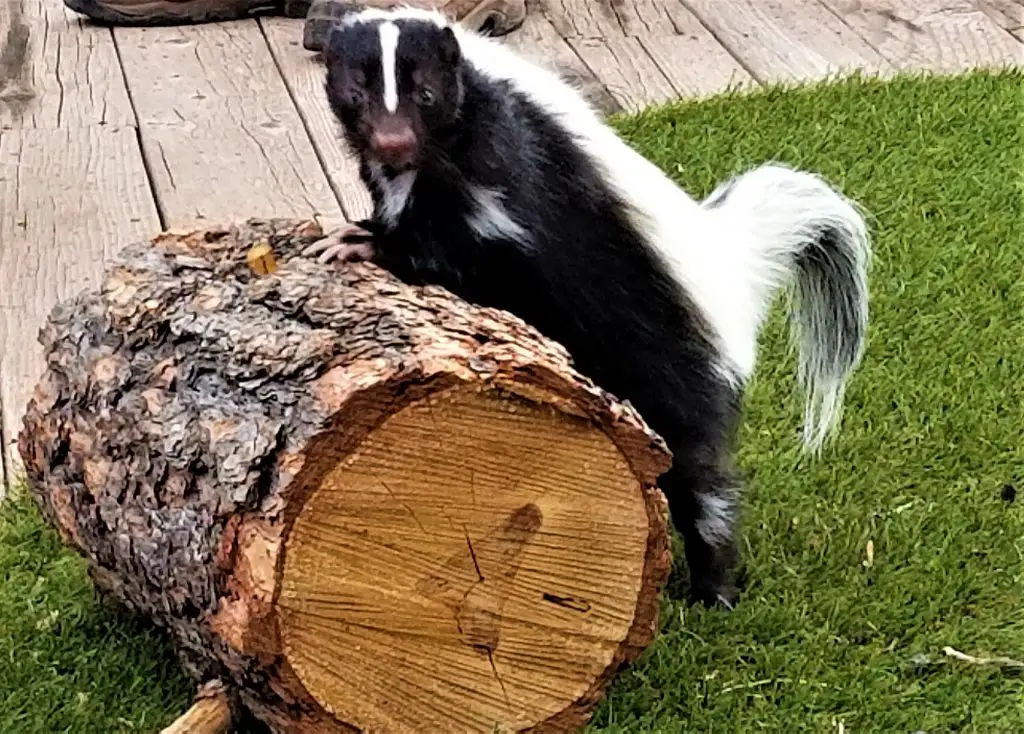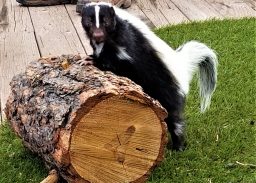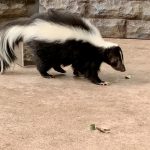Only 2 species of skunks can climb trees, its the Eastern and Western Spotted Skunk they a know for; raiding beehives and sleeping in hollows. Larger skunks aren’t so agile and can’t climb trees.

When Do Skunks Climb Trees?
Skunks in general are fossorial animals – they live on and under the ground. With large strong claws – they can dig for prey, move rocks and excavate burrows.
Add to the fact that skunks are usually quite bulky too – climbing trees like squirrels isn’t their thing. They can scurry up, and balance well on, low branches, logs, and fallen trees.
Two of the smaller skunks in the U.S. – the Eastern Spotted (Spilogale putorius) and Western Spotted (S. gracilis) are, however, very agile – and love climbing trees to feast on honey and birds eggs. They are lighter than the Hog-nosed and Striped skunks and have claws that are more suited to clambering up a tree. They also sometimes sleep up in tree hollows or on thick branches when the weather is conducive.
Larger skunks just don’t have the ability to grip onto a vertical surface – without assistance. Low branches, twisted trees, and stacked wood however will allow them to gain height rather through luck than through skill. Leaving buildings to become abandoned or stacking things up against them can help a larger skunk find a cozy den in the walls or rafters. If you only have upright trees around your home though and smell a skunk, it won’t be one of these larger guys.
Do Skunks Live In Trees?
In general, skunks are den-dwellers. They choose a dry site underground – ideally in a hole that someone else has already dug – but they have powerful front legs to do the digging themselves when needed. What they don’t normally do is make a nest in a tree.
As said above, only the smaller spotted skunks can even really climb trees and so this isn’t a popular option for the other 8 skunk species across the continent.
Underground is also warmer – so being exposed in a tree could mean they have to eat more – or migrate away from their current home range. Luckily though – they don’t have to hide up a tree to evade predators – as they have other means of defense should anyone accidentally creep into the wrong den.
They may also be quite vulnerable in the tangled branches as it would make it harder for them to use their world-famous spray. Aiming it with pinpoint accuracy over 10ft or more just wouldn’t be possible up there.
Will Skunks Eat Trees And Leaves?
Skunks also don’t really eat anything in trees – or parts of trees. They are carnivorous by design with jaws and teeth similar to that of a cat. Chewing on bark or leaves just isn’t on the menu. Skunks mainly eat insects and small rodents – prey that usually lives in fields and meadows or underneath rocks and leaves – and is easily digested. Plant material takes a lot of effort to live on – and is not for skunks.
Also, living in a tree wouldn’t make feeding very easy for them even if they did eat plant material. What with their blunt claws and wide bodies – they aren’t the most steady up high – and are likely to fall. Only the spotted skunks could adapt to life in the branches – but even then it would have to be a very well-stocked woodland to make that possible.
Can Skunks Spray while Climbing Trees?
Skunks are notorious for their smelly defense mechanism, but have you ever wondered how far skunks spray? Interestingly, skunks can spray up to 10 feet away, even while climbing trees. This potent spray is their primary defense against predators, making them a formidable force in the animal kingdom.
Can Skunks Climb Trees like Tasmanian Devils?
Can skunks climb trees like Tasmanian devils? While the tasmanian devil’s tree-climbing abilities are well-known, skunks, on the other hand, are not natural climbers. Skunks rely on their strong digging abilities and sharp claws to find food on the ground rather than ascending trees. Unlike the agile and nimble Tasmanian devils, skunks prefer to stay closer to the earth.
Can Skunks Climb Fences?
Most skunks can easily clamber over a yard fence. Whether it is wooden, barred, brick, or stone – all these types offer footholds that a skunk can take advantage of. If your yard smells good or has a den site in it – a skunk will put in a bit of effort to get over any barrier – or round it.
Obviously, the higher, wider, and smoother your fence becomes – the fewer skunks can get over. Also, if the barrier is sufficient and there is absolutely no reason for the skunk to want to come over – then you are increasing your chances of a skunk-free yard even more.
However, they are fossorial remember – so if they can’t get over – they will try to get under. Digging is easy for them – and they are persistent – so digging as deep as 2ft down to circumnavigate a fence is simple. Something most people don’t think of.
A fence to keep out skunks would therefore need to be completely smooth – over 2ft tall – as well as over 2ft deep. It would also need to be the entire length of your plot perimeter too – otherwise, these smart cookies will just walk around it.











